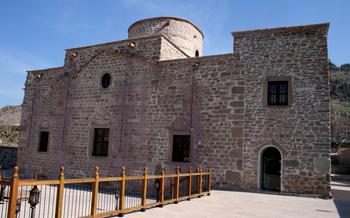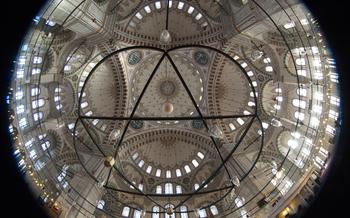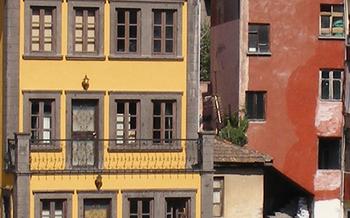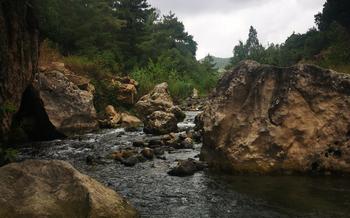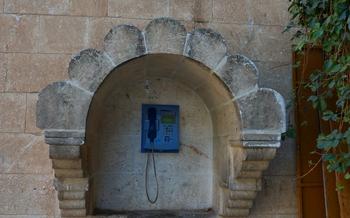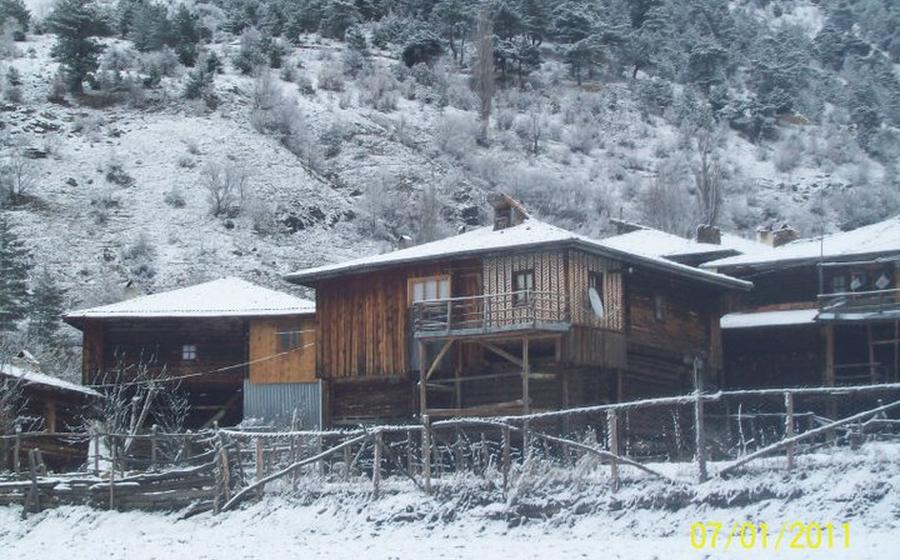
Becikli Kilise a rock cut church near İskilip
- Becikli Kilise: A Hidden Gem in Çorum
- Location: Finding the Enchanting Church
- History Unveiled: A Journey Through Time
- Architectural Masterpiece: Unraveling the Design
- Cultural Significance: A Bridge to the Past
- Practical Information: Planning Your Visit
- Exploring the Church's Interior
- History of Christianity in Çorum
- Preservation and Restoration Efforts
- Local Legends and Folklore
- Religious Significance for Christians
- Tips for Photography Enthusiasts
- Nearby Attractions for a Complete Experience
- Insider Tip: Hidden Chamber Discovery
Becikli Kilise: A Hidden Gem in Çorum
Nestled in the heart of Çorum, Turkey, lies a hidden gem that beckons history enthusiasts and pilgrims alike – the Becikli Kilise, an awe-inspiring rock-cut church that has stood the test of time. Built during the Byzantine era, this remarkable church boasts a unique architectural style and is adorned with intricate carvings and frescoes that tell tales of a bygone era. As you step into this sacred space, you'll be transported back in time, surrounded by the echoes of ancient prayers and the tangible presence of history.
Historical Significance:
The Becikli Kilise holds immense historical significance as a testament to the region's rich Christian heritage. Dating back to the 10th century, the church played a pivotal role in the spread of Christianity during the Byzantine Empire. Its construction marked a period of religious devotion and architectural innovation, leaving an indelible mark on the cultural landscape of Çorum.
Architectural Features:
Carved into a natural rock formation, the Becikli Kilise showcases an extraordinary architectural feat. Its facade is adorned with intricate carvings, while the interior boasts a series of chambers, alcoves, and an apse that exude an atmosphere of serenity and devotion. The church's unique design and construction techniques have earned it recognition as one of the most remarkable examples of rock-cut architecture in the region.
Religious Symbolism:
Step inside the Becikli Kilise, and you'll be surrounded by a wealth of Christian symbolism and iconography. The church's walls are adorned with frescoes depicting biblical scenes and religious figures, each carrying profound meaning and symbolism. From the intricate carvings of saints to the depiction of the crucifixion, the church's interior is a testament to the deep faith and devotion of its builders.
Cultural Heritage:
The Becikli Kilise is an integral part of Çorum's cultural heritage, representing a time when Christianity flourished in the region. It has served as a place of worship, a refuge for pilgrims, and a source of inspiration for generations. The church's enduring legacy lies in its ability to bridge the past and the present, offering a glimpse into the rich tapestry of Çorum's religious and cultural history.
Location: Finding the Enchanting Church
Becikli Kilise's secluded location adds to its allure, nestled amidst the tranquil countryside of Çorum. To reach this hidden gem, embark on a scenic journey from the city center, following the signs towards İskilip. As you approach the village of Oğuzlar, keep an eye out for a small road leading to the church. The drive offers breathtaking views of rolling hills, lush greenery, and charming villages.
Once you arrive at the church, you'll find ample parking space to leave your vehicle and begin your exploration. While the church itself is easily accessible, the surrounding terrain may present some challenges for visitors with mobility issues. However, the rewards of exploring this unique site far outweigh any minor inconveniences.
In the vicinity of Becikli Kilise, you'll discover a wealth of other attractions that will enhance your visit. The picturesque village of Oğuzlar, with its traditional architecture and friendly locals, is worth exploring. Don't miss the opportunity to indulge in local delicacies at one of the village's charming restaurants. For history enthusiasts, the nearby İskilip Castle stands as a testament to the region's rich past and offers stunning panoramic views of the surrounding countryside.
History Unveiled: A Journey Through Time
The history of Becikli Kilise is a captivating tale that spans centuries, intertwining with the rich tapestry of Çorum's cultural and religious heritage. In the early days of Christianity, the region witnessed the fervent growth of the faith, and the church emerged as a sanctuary for the devout.
During the Byzantine era, Çorum fell under the influence of the mighty Byzantine Empire, leaving an indelible mark on the church's architecture and iconography. The Byzantine emperors, known for their patronage of the arts, commissioned elaborate embellishments and frescoes that transformed the church into a radiant beacon of Christianity.
With the rise of the Ottoman Empire, Çorum came under Islamic rule, marking a significant chapter in the church's history. While the Ottomans generally respected the rights of non-Muslim communities, the church faced certain restrictions and challenges. Despite these obstacles, the church endured as a testament to the region's enduring Christian heritage.
In recent times, archaeological excavations and research have shed new light on the church's history. These discoveries have provided valuable insights into the construction techniques, artistic influences, and religious practices that shaped the church's evolution. Ongoing research continues to unveil the hidden depths of Becikli Kilise's past, enriching our understanding of this remarkable monument.
Architectural Masterpiece: Unraveling the Design
Becikli Kilise stands as a testament to the ingenuity and craftsmanship of its creators. Carved directly into a natural rock formation, the church exhibits an impressive feat of engineering. The exterior facade is adorned with intricate carvings and embellishments, showcasing the skill and artistry of the builders. Step inside, and you'll be greeted by a series of chambers, alcoves, and an apse that form the church's interior. Each space is carefully designed, with unique features that contribute to the overall grandeur of the church. From the intricately carved capitals atop the columns to the delicate frescoes adorning the walls, every detail has been meticulously crafted to create a harmonious and awe-inspiring environment that transports visitors back in time.
Cultural Significance: A Bridge to the Past
Becikli Kilise stands as a testament to the rich cultural heritage of Çorum, embodying the region's diverse religious history. The church has played a pivotal role in shaping local traditions and customs, becoming an integral part of the community's identity. Over the centuries, it has served as a place of worship, pilgrimage, and spiritual reflection, fostering a sense of unity among the local population.
As a pilgrimage site, Becikli Kilise attracts visitors from near and far who seek spiritual enlightenment and connection with their faith. The church's unique architecture, coupled with its religious symbolism, creates a sacred space that inspires awe and reverence. Pilgrims often visit the church to pay homage to the saints and martyrs associated with the site, seeking blessings and divine guidance.
Moreover, Becikli Kilise serves as a symbol of tolerance and religious harmony in the region. Throughout history, Çorum has been home to diverse religious communities, including Christians, Muslims, and Jews. The church's existence amidst this diversity stands as a testament to the peaceful coexistence and mutual respect that have characterized the region. Becikli Kilise represents the shared cultural heritage of Çorum, where different faiths have intertwined and enriched the local tapestry of traditions and beliefs.
In recent years, there has been a growing recognition of the church's cultural significance, leading to increased efforts to preserve and protect this unique heritage site. Local authorities and international organizations have collaborated on restoration projects to safeguard the church's architectural integrity and ensure its longevity. These efforts reflect the deep appreciation for the church's historical and cultural value, ensuring that it continues to serve as a bridge to the past and a source of inspiration for generations to come.
Practical Information: Planning Your Visit
Visiting Becikli Kilise offers a unique and enriching experience for travelers interested in history, architecture, and religious heritage. To ensure a smooth and enjoyable visit, it's essential to plan ahead and be aware of practical considerations.
Visiting Hours: The church is open to the public during specific hours, typically from 8:00 AM to 5:00 PM daily. It's advisable to check the official website or contact local tourism authorities for any seasonal or temporary changes in visiting hours.
Admission Fees: Entry to Becikli Kilise is free of charge, allowing visitors to explore the church's interior without any financial burden. This accessibility makes it an excellent destination for travelers on a budget or those seeking a free cultural experience.
Guided Tours: If you're looking for a deeper understanding of the church's history, symbolism, and architectural features, guided tours are available at an additional cost. These tours are led by knowledgeable guides who provide insightful commentary and anecdotes, enhancing your overall experience.
Photography Guidelines: Photography is permitted within the church, allowing visitors to capture the intricate details, artwork, and overall ambiance of the site. However, it's essential to be respectful and avoid using flash photography, as it can damage the delicate frescoes and artwork. Additionally, some areas of the church may have photography restrictions, so it's advisable to inquire with the staff or guides before taking pictures.
Exploring the Church's Interior
As you step inside Becikli Kilise, you are greeted by a sense of awe and tranquility. The main chamber, with its high vaulted ceiling and intricate carvings, draws your attention immediately. The walls are adorned with beautifully preserved frescoes depicting biblical scenes and Christian symbolism. The natural light streaming through the windows casts a warm glow, illuminating the vibrant colors and delicate details of the artwork.
To the left and right of the main chamber, you will find two smaller side chapels. These chapels were likely used for private worship or prayer. They feature similar architectural elements to the main chamber, but on a smaller scale. The altar area, located at the far end of the church, is the most sacred space. It is elevated from the rest of the church and features a beautifully carved altar table. The apse, behind the altar, contains a stunning mosaic depicting Jesus Christ surrounded by angels.
As you explore the church's interior, take some time to notice the hidden details and subtle elements that might easily be missed. Look for carved inscriptions, geometric patterns, and other decorative motifs that add to the richness of the church's design. These details offer a glimpse into the minds and hearts of the artisans who created this sacred space centuries ago.
History of Christianity in Çorum
Christianity has a long and significant history in Çorum, dating back to the early centuries of the Common Era. The region was part of the Roman province of Cappadocia, which was a center of early Christian activity. In the 4th century, Çorum became a bishopric, and several churches and monasteries were built in the area. The most notable of these is the Becikli Kilise, a rock-cut church that dates back to the 6th or 7th century.
During the Byzantine period, Çorum remained a predominantly Christian city. However, after the Seljuk Turks conquered the region in the 11th century, the Christian population began to decline. By the 15th century, Çorum had become a predominantly Muslim city.
Despite the decline of the Christian population, there are still several Christian churches and monasteries in Çorum today. These include the Surp Krikor Lusavorich Armenian Church, the Greek Orthodox Church of the Holy Trinity, and the Catholic Church of St. Anthony.
The history of Christianity in Çorum is a reminder of the region's rich and diverse cultural heritage. The Becikli Kilise and other Christian monuments are a testament to the enduring legacy of Christianity in the region.
Preservation and Restoration Efforts
Preserving the unique features of Becikli Kilise presents a number of challenges. The church's age and exposure to the elements have taken a toll on its structure, making it susceptible to decay and deterioration. In response to these challenges, extensive restoration projects have been undertaken to protect and conserve the church for future generations.
Past restoration efforts have focused on stabilizing the church's structure, repairing damaged sections, and addressing issues related to moisture and water infiltration. Skilled craftsmen and artisans have meticulously worked to restore the church's intricate carvings, frescoes, and iconography, using traditional techniques and materials to maintain its authenticity.
Ongoing restoration projects continue to address the ongoing challenges of preserving the church. Regular maintenance and monitoring are essential to ensure the church's long-term stability. Additionally, sustainable tourism practices are being implemented to minimize the impact of visitors on the church's delicate environment.
By combining traditional restoration techniques with modern conservation practices, experts are working tirelessly to ensure that Becikli Kilise remains a testament to the region's rich cultural and religious heritage.
Local Legends and Folklore
Becikli Kilise is deeply intertwined with the local legends and folklore of Çorum. One captivating myth associated with the church tells the tale of a hidden treasure buried beneath its foundation. According to legend, a wealthy Byzantine aristocrat, fearing invasion and persecution, concealed his vast riches within the church's walls. Many have attempted to locate this hidden treasure, but none have succeeded, fueling the intrigue and mystery surrounding the church.
Local folklore also speaks of a benevolent spirit that resides within the church, protecting it from harm and guiding visitors who seek its blessings. Stories abound of miraculous occurrences and answered prayers, further enhancing the church's sacred status among the local population.
These legends and tales, passed down through generations, have become an integral part of the cultural identity of Çorum, adding a layer of enchantment to the already remarkable Becikli Kilise.
Religious Significance for Christians
Becikli Kilise holds immense religious significance for Christians as a renowned pilgrimage site. Devout believers from various parts of the world embark on spiritual journeys to visit this sacred church. The intricate iconography and symbolism found throughout the church's interior evoke a profound sense of spirituality and connection with the divine. Pilgrims often light candles and offer prayers within the church, seeking blessings and guidance. Religious ceremonies and events, such as masses and special services, are occasionally held within the church, attracting a large number of faithful attendees. For many Christians, visiting Becikli Kilise is a deeply moving and transformative experience that strengthens their faith and deepens their connection with their religious heritage.
Tips for Photography Enthusiasts
For photography enthusiasts, Becikli Kilise offers a treasure trove of opportunities to capture stunning images. The best time to visit for optimal lighting conditions is during the golden hours of sunrise and sunset, when the warm hues bathe the church in a magical glow. To capture the grandeur of the church's exterior, experiment with different angles and perspectives. Try shooting from a low angle to emphasize its imposing presence against the sky, or position yourself at a distance to capture the church within its natural surroundings. For interior shots, focus on the intricate details and textures that adorn the walls and ceiling. Utilize natural light to create dramatic shadows and highlights, and don't hesitate to explore different vantage points within the various chambers to capture unique compositions. With a keen eye and a bit of patience, you'll be able to immortalize the beauty of Becikli Kilise in your photographs.
Nearby Attractions for a Complete Experience
Enhancing your journey to Çorum involves exploring the diverse attractions that complement the enchanting Becikli Kilise. Among these, İskilip Castle stands as a testament to the region's rich history. Its imposing walls and well-preserved architecture offer a glimpse into the past, inviting you to delve into tales of conquest and defense.
Venturing beyond historical sites, Çorum's culinary scene beckons with tantalizing flavors. From traditional Turkish dishes to local delicacies, the city's restaurants offer a culinary adventure that will delight your taste buds. Indulge in the aromatic kebabs, savor the freshness of grilled vegetables, and satisfy your sweet tooth with delectable desserts.
Nature enthusiasts will find solace in the breathtaking natural wonders surrounding Çorum. Majestic waterfalls cascade amidst lush greenery, inviting you to immerse yourself in the tranquility of nature. Ascend towering mountains for panoramic vistas that will leave you breathless, or seek serenity in the tranquil embrace of serene parks.
With its captivating blend of history, gastronomy, and natural beauty, Çorum promises an unforgettable experience that extends beyond the walls of Becikli Kilise. Embrace the opportunity to explore these nearby attractions and create lasting memories in this vibrant and welcoming region.
Insider Tip: Hidden Chamber Discovery
Beyond the main chambers and chapels of Becikli Kilise lies a hidden gem known only to a select few. Tucked away in a secluded corner, this secret chamber is a testament to the church's rich history and intricate design.
The entrance to the hidden chamber is discreetly concealed, requiring a keen eye to locate. Once discovered, visitors are greeted by a small, dimly lit space that exudes an aura of mystery and intrigue. The walls are adorned with faded frescoes depicting biblical scenes and symbolic motifs, hinting at the chamber's once-sacred purpose.
The hidden chamber is believed to have served as a sanctuary or retreat for monks or religious leaders during times of persecution or turmoil. Its secluded location provided a safe haven for those seeking refuge and contemplation.
Exploring this hidden chamber is a unique and rewarding experience for visitors who seek to delve deeper into the history and secrets of Becikli Kilise. It offers a glimpse into the hidden aspects of the church and provides a tangible connection to the past.
